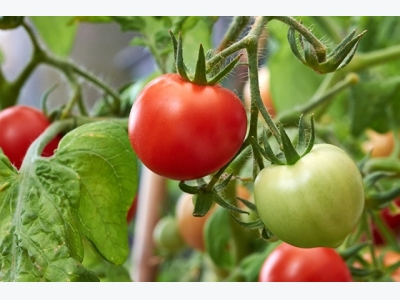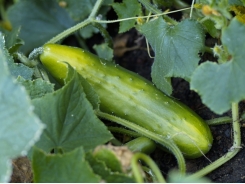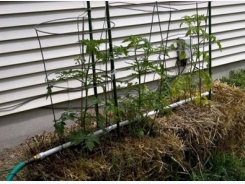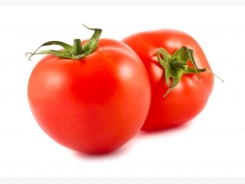Expert Tips for Growing Tomatos Outdoors

Tomatoes are most accommodating plants but when they are to be grown outdoors a really good start under the right conditions is essential to ensure complete success.
Since they are frost tender, weather conditions and the state of the soil must be such that growth continues unchecked once the plants have been placed in the open ground. It is not wise to do this until frosts have passed.
Many gardeners now use hormone setting sprays when atmospheric conditions are unsuitable for natural fertilisation, or where growth is rank and flowers fail to set fruit. With good culture these aids should not be necessary, but it is important to get the bottom truss of fruit to set for this encourages even, healthy growth and improves both the quality and setting tendency of later trusses.
Intermittent drying out and heavy watering leads to irregular growth as well as cracked fruit. When growing tomatos, a surface mulching of peat, leaf mould, or similar material will help to maintain a cool root run which is beneficial to the plants, and prevents the surface soil from drying out.
If you are growing tomatos on deep well prepared land, artificial watering is seldom needed. If it can be avoided so much the better, for continued watering brings the roots near the surface, where they suffer from dryness much more than when they are deep in the soil.
If the soil has been well prepared and enriched, it should be unnecessary to give extra feeding. Should growth become extra luxuriant and rank, a dressing of seaweed manure scattered round the plants and watered in, will help to steady development.
Outdoors, it should easily be possible to bring three trusses of fruit to maturity. If the position is warm and sheltered and the weather good, a fourth truss can sometimes be allowed. There is not point in allowing plants to waste their strength on growth and flowers from which it is impossible to secure fruit. When the chosen number of trusses has been selected, the plants should be stopped at one leaf beyond the top truss and from that time, one or two side shoots can be allowed to develop.
This will keep the sap flowing and discourage fruit splitting which sometimes occurs once the plants have been stopped. The excess of sap then goes into the fruit, which cannot expand fast enough, causing the skin to crack, particularly if heavy rains follow a period of dry weather. Discoloured and old leaves can be removed, which will improve air circulation as well as help to lessen the possibility or spread of blight.
Gather the fruit as soon as it is well coloured. In some areas, birds will peck the fruit once it is tinted. Often they are only seeking moisture, so it is helpful to place shallow containers of water near the plants. This also works among other crops, both vegetables and flowers, which birds sometimes attack, particularly during spells of hot, dry weather.
If in autumn, some fruit is still unripe, the complete trusses should be cut off and hung up in the warm greenhouse or living room. Alternatively, fruits can be gathered individually and wrapped in paper and placed in a drawer or box, where warmth and darkness. will bring out the colour. Kept in this way, ripening fruit will be available over a period of weeks.
Autumn and Winter Tomato Fruiting
By careful planning when growing tomatos, ripe fruit will be available from the greenhouse well after the summer, a time when fresh fruit is appreciated. For late fruiting, seed should be sown towards the end of spring using boxes of good compost which have a layer of peat placed at the bottom. For a winter crop sow in summer. Space the seed at least 25mm apart and cover the boxes with paper to prevent them drying out. Remove the covering once germination occurs. This spacing results in the minimum root disturbance at pricking of time.
It also allows seedlings to be moved straight from the seed boxes to small 6cm size pots, larger sizes being given as growth develops. By the time 20 to 23cm pots are reached, the plants should be sturdy and in full growth. Keep them under cool conditions for a week or two. Then stand outdoors in a sheltered place for a couple of months.
For the final potting, provide a good layer of drainage crocks and use a soil mixture such as four parts turfy loam, one part of strawy horse manure, and a good sprinkling of hoof and horn meal, or wood ash. While outside, feed the plants with liquid manure. This encourages short, stocky growth and strong fruit trusses. Fish meal can be lightly worked into the surface soil and in the pots and watered in. Take the plants into the greenhouse towards the end of summer. Air and light are essential, with a night temperature of 10°C. The ripening process will be slow, but the fruit colours up evenly.
Related news
Tools

Phối trộn thức ăn chăn nuôi

Pha dung dịch thủy canh

Định mức cho tôm ăn

Phối trộn phân bón NPK

Xác định tỷ lệ tôm sống

Chuyển đổi đơn vị phân bón

Xác định công suất sục khí

Chuyển đổi đơn vị tôm

Tính diện tích nhà kính

Tính thể tích ao




 Growing Tomatoes: Patio Tomatoes – Growing Outdoor Tomatoes
Growing Tomatoes: Patio Tomatoes – Growing Outdoor Tomatoes  Expert Tips for Tomato Ring Culture Supergrowth
Expert Tips for Tomato Ring Culture Supergrowth